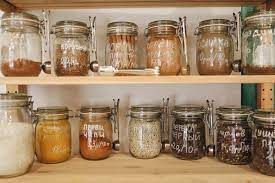Your Cart is Empty
FREE Worldwide Shipping! | +1 365 654 6605
FREE Worldwide Shipping! | +1 365 654 6605
February 21, 2024 3 min read

Pet food storage is a crucial aspect of pet care that often goes unnoticed. Ensuring that your pet's food is stored properly helps maintain its nutritional value, taste, and safety. This article will guide you through the best practices for storing pet food, the dangers lurking in improper storage methods, and the importance of keeping the food in its original packaging. Storing your pet's food correctly is essential for multiple reasons. First, it helps preserve the nutritional value of the food. Once exposed to air, pet food begins to oxidize, which can lead to a decline in its nutritional content. Second, proper storage keeps the food fresh and tasty for your pet. Lastly, it prevents the growth of mold and bacteria, which can cause foodborne illnesses. The ideal conditions for storing pet food include a cool, dry place with a temperature below 80 degrees Fahrenheit. Avoid storing pet food in locations with high temperatures, as this can speed up the degradation process and cause the nutrients within the food to break down. Also, keep the food away from direct sunlight and moisture to prevent the growth of mold. One common practice among pet owners is transferring pet food from its original packaging into a plastic storage bin. However, this practice can be dangerous. The animal fats, vegetable fats, and marine oils in pet food can settle on the bottom and sides of the bin and become rancid over time. This can lead to a decline in the food's nutritional value and potential health risks for your pet. Most plastic bins are made of polycarbonate plastics, which often contain Bisphenol A (BPA), a harmful chemical that can seep into pet food over time. BPA is an endocrine disruptor that can cause severe health problems, including developmental, neurological, and reproductive health issues. Even BPA-free products can release synthetic estrogens that are more potent than BPA, posing additional health risks. Plastic storage bins also increase the risk of storage mites, mold growth, and bacterial contamination. These can often lead to food poisoning, vomiting, and/or diarrhea. Therefore, it's crucial to avoid using plastic bins for storing pet food or to use them properly to minimize these risks. Pet food manufacturers invest time and money into their packaging technology to preserve the food's freshness. Therefore, it's best to keep the food in its original packaging. This not only helps maintain its freshness but also provides immediate access to lot numbers and dates in case of a recall or if your pet becomes ill. If you choose to use storage containers, always keep the food in the original packaging and then place it into the bin. Ideal storage containers should have an air-tight seal to prevent oxidation. Options include rolling plastic bins with wheels, plastic storage vaults with circular lids for an air-tight seal, metal storage bins with air-tight lids, and glass jars with air-tight lids. Regularly cleaning the storage containers is essential to prevent the buildup of rancid oils. Always wash the container with warm, not hot water and a high-quality dishwashing detergent. Ensure the container is completely dry before placing any pet food bags in it. Aim to use the pet food within a month to six weeks of opening the bag. This helps ensure that the food remains fresh and nutritious for your pet. Additionally, avoid adding new food to old food, as this can spread any potential contamination to the new food and hasten the development of rancidity. Proper storage of pet food is crucial for maintaining its nutritional value, taste, and safety. Avoid using plastic storage containers, as they can pose several health risks to your pets. Instead, keep the food in its original packaging and store it in a cool, dry place. Regularly clean the storage containers and aim to use the food within a month of opening the bag. By following these best practices, you can ensure that your pet's food remains fresh, tasty, and safe for consumption.Understanding Pet Food Storage
The Importance of Proper Storage
Ideal Storage Conditions
Dangers of Plastic Storage Containers
The Risk of Oxidation
BPA and Other Harmful Chemicals
Risk of Contamination
Best Practices for Storing Pet Food
Keep the Original Packaging
Use Suitable Containers
Regular Cleaning
Use Within a Month
Conclusion
References
Be the first to know about upcoming sales and promos. Get a 10% discount coupon when you subscribe!